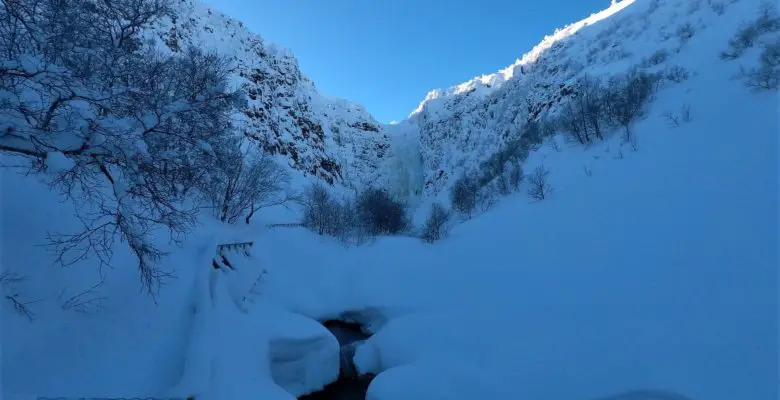
Njupeskär Waterfall & Fulufjället National Park
Fancy an abundance of snow, ice, and a winter wander among towering 400-year-old spruce trees taking in Sweden’s highest waterfall? The Njupeskär Waterfall walk truly spoils you with a winter paradise that is hard to beat!
Deciding on the Njupeskär Waterfall Walk
Prior to visiting my Mum in Dalarna, Sweden in February 2018, Didem and I had already decided that we had to slot at least one exciting winter hike into our holiday schedule.
As we searched the web for winter hiking adventures in Dalarna, we came across a series of images of Njupeskär, Sweden’s highest waterfall.
What we saw was a perfect winter paradise; an abundance of snow, a totally frozen waterfall, towering spruce forests and a remote mountain national park – and a 4km hike through its winter wonderland!
Although the Fulufjället national park attracts in excess of 50,000 visitors each year, the large majority of these come in the summer months. We were, therefore, hoping that we were going to be able to enjoy the wonders of Njupeskär and Fulufjället national park in peaceful isolation.
With its remote location coupled with February’s hostile weather conditions, we had a feeling that we would not be disappointed!
Where is Njupeskär?
Njupeskär is located in the Fulufjället National Park in the province of Dalarna. Check out the waterfall’s location on the map below:
Swedish winters are certainly not new to me as I have visited during these months many times since the 1980s. However, this area of Dalarna is fairly remote and receives more snow on average than any other part of the province.
We checked that the roads and parking areas would actually be accessible as there had been particularly heavy snowfall throughout the winter of 2018, in this location.
In fact, some suggested that it was as far back as 1966 when Dalarna had last experienced snow quantities of this magnitude!
How to get to Njupeskär?
My Mum lives in Mora, Dalarna so our day trip to Njupeskär involved a 300km round trip. See our chosen route on the map below:
We set out at 07:30, before sunrise, knowing that the sun would be setting at 1619. Not only did we have a long drive, we were not 100% sure of the weather conditions at our location. We thankfully chose a day when sun was forecast and there was only a very slight chance of snowfall, so things did look good for us.
Coming from the UK, we are used to driving on roads that remain clear of snow for pretty much the whole year. What’s more, it is not unusual for us to drive on dual carriageways (2 lanes in either direction). Also, road markings are clearly visible.
The highway 70 that leads north from Mora is a single carriageway in each direction and in February is totally covered by a sheet of white. Not only is the centre line not visible but the roadsides were little more than a bank of snow created by snow ploughs.
It is therefore simply not possible to maintain the sort of speeds on these roads that we can in the UK.
One of the wonderful things about driving on Swedish roads, especially in Dalarna in winter, is the distinct lack of vehicles. In fact, heading north up highway 70 there was little more to see than forests, frozen lakes and snow – lots of it!
About 40 km north of Mora we drove through the small town of Älvdalen. Just a few kilometres north of Älvdalen, we really began to get the feeling that we were heading into the wilderness.
For the next 80 km there is very little evidence of life and definitely no petrol stations. So, ensure that you fill up in Älvdalen if you are running low on fuel!
This 80 km stretch really gives you the opportunity to marvel at the sheer beauty of nothingness. If it were not for the occasional passing vehicle, you really could think that you were heading to the end of the world!
Upon entering Särna (population 791) you can get the feeling that the town is a lot bigger than it actually is. This is probably due to the fact that you have barely seen a house or person for the last hour on the road.
Just a couple of kilometres out of Särna, we turned left on to the 1056 and headed towards the village of Mörkret, translated literally means ‘darkness’.
As if we were not already remote enough, we now had a real sense that things were hardly going to get more lively as we headed towards the ‘darkness’.
We remained on this road for 21 km until we entered Mörkret. Here we turned left and drove the remaining 6 km to the parking area at Fulufjället National Park and the starting point of the Njupeskär Waterfall Walk.
Seeing no other vehicles there, it very much looked like we were going to have the Njupeskär Waterfall Walk all to ourselves!
Njupeskär Waterfall Walk
At first, we couldn’t work out where the walk actually started, so we headed for the naturum Fulufjället visitor centre. We were not exactly shocked that it was closed especially as there had been no cars in the car park!

Thankfully, we then spotted a ‘Njupeskär 2’ sign that was partially covered with snow. There were also footprints in the snow leading off down this path, so we were confident that this was indeed the way to go.
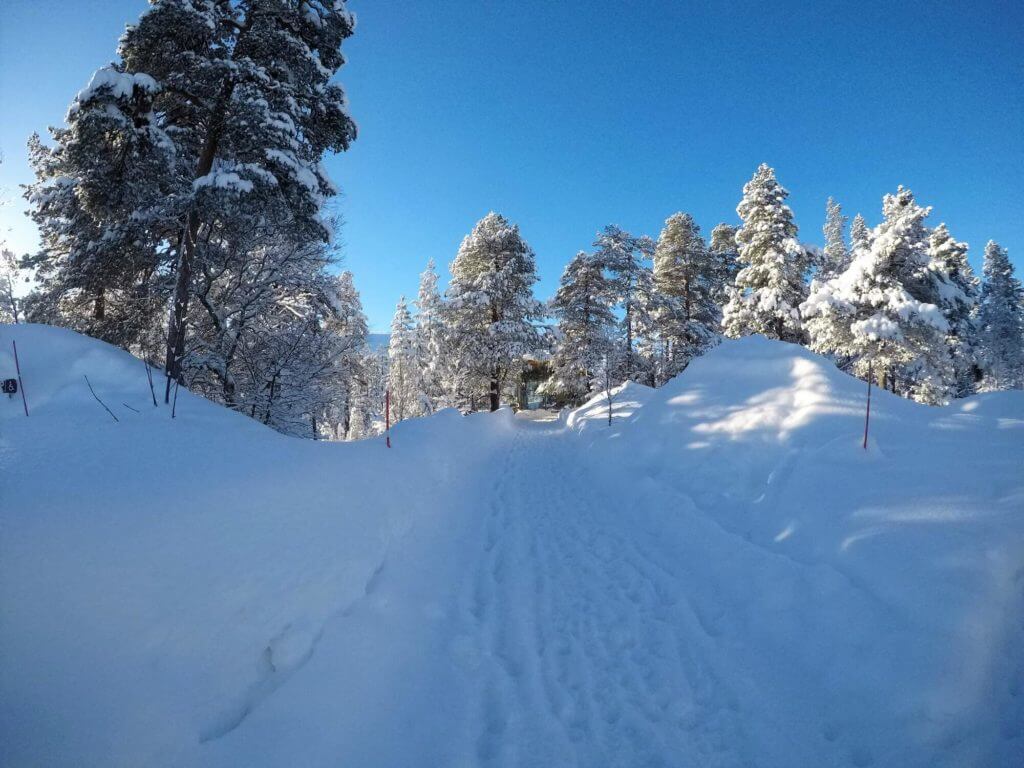
It is amazing how much more cautious you become when you are in a remote location, with no one else around and a temperature of -18°C! The one thing we really didn’t want to do was to set off in the wrong direction in such hostile conditions.
The first 10-15 minutes of the walk was beautifully flat and open and with well-spaced spruce trees, we enjoyed unobstructed views towards the mountains of Fulufjället ahead.
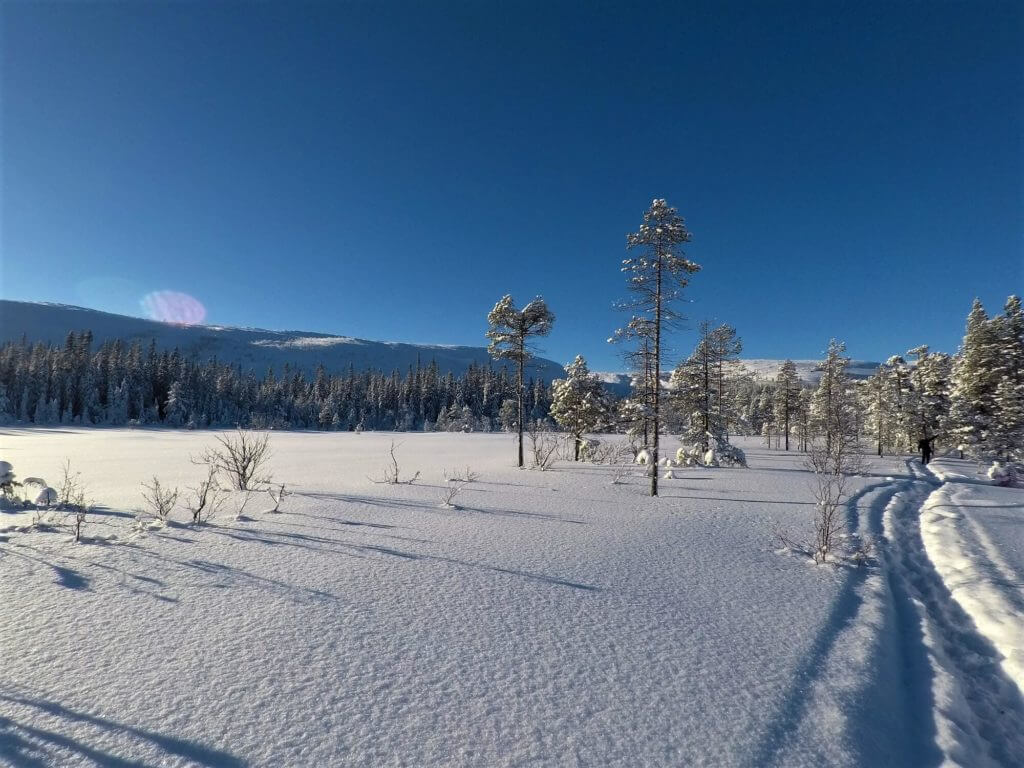
Although the snow was deep, it was well compacted mainly thanks to the hikers who had recently walked the path.
There was not a breath of wind and the morning sun glistened off the snowpack. It was like we were wading through a sea of diamonds!
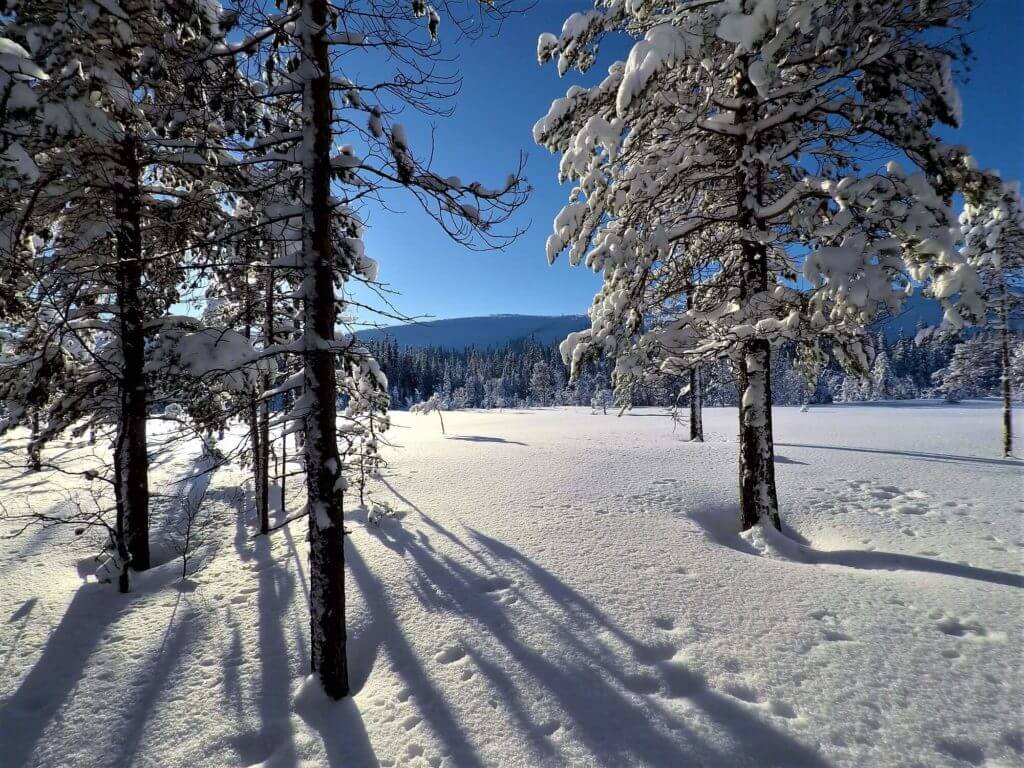
The only sound that we could hear was the crunching of our hiking boots through the deep snow with every step that we took. Every so often I would stop just to hear what sounds nature had to offer and all that came back was a deafening silence!
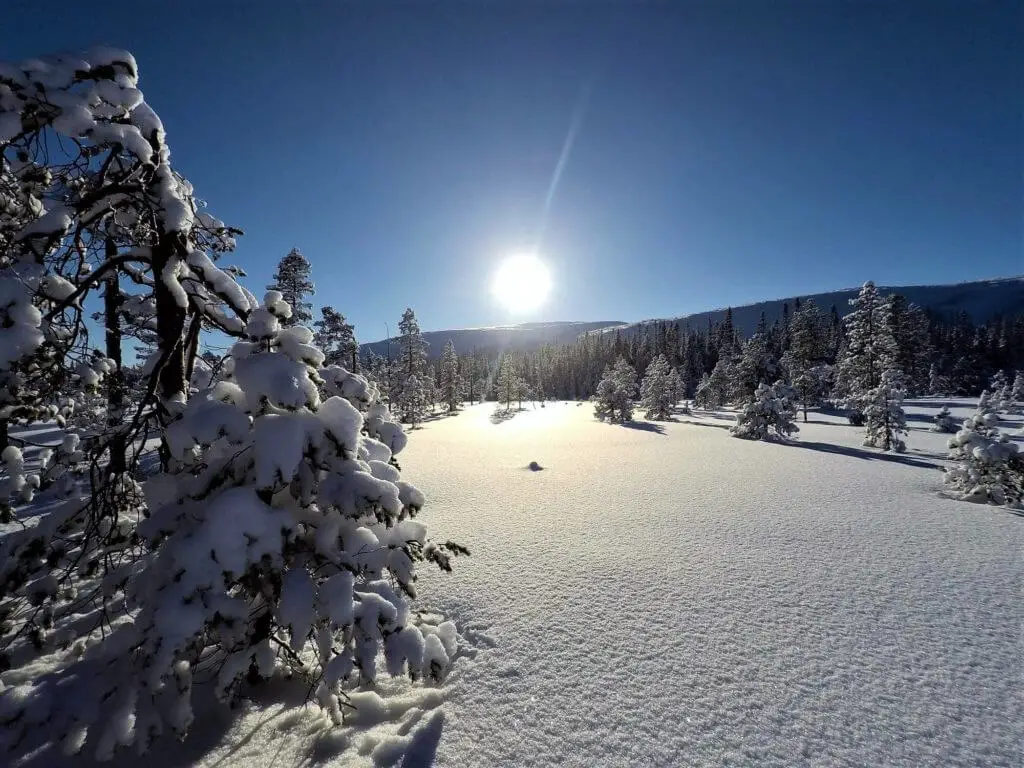
As we progressed, the spruce trees became more densely packed and for the next 40 minutes the path meandered amongst these 400-year-old giants. We got a real sense of just how the Lilliputians must have felt in “Gulliver’s Travels”.
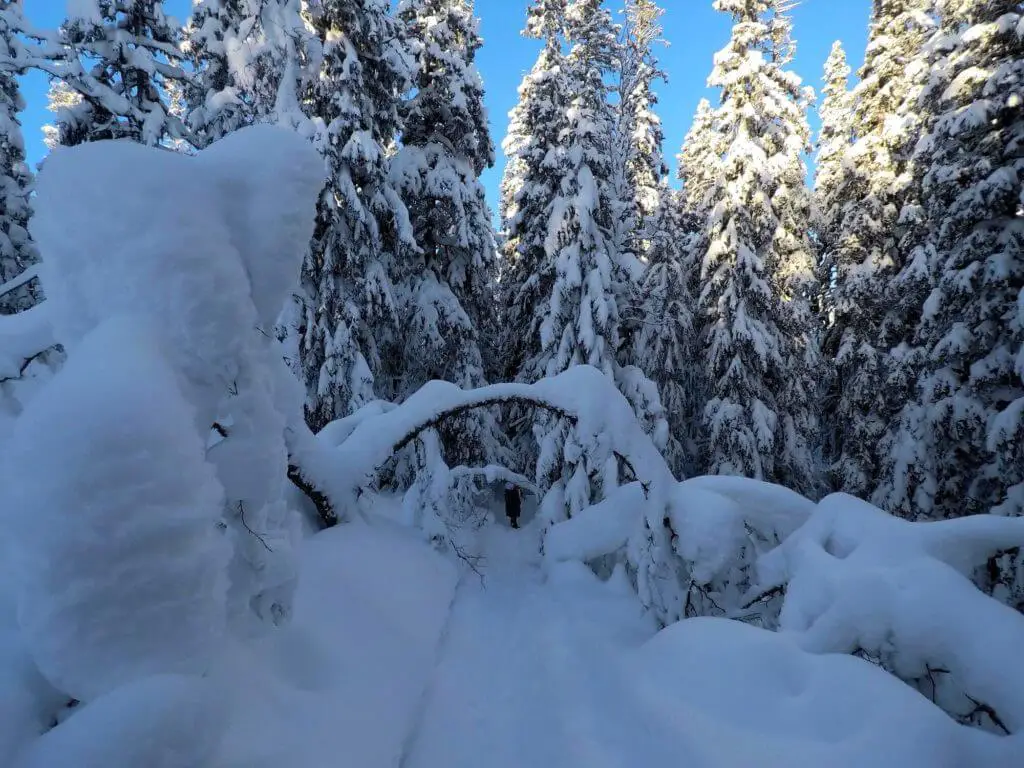
Although the path was generally flat, there were a few modest inclines and declines. It was at these points when the snow was deeper and at times you would lose half your leg beneath the snow.
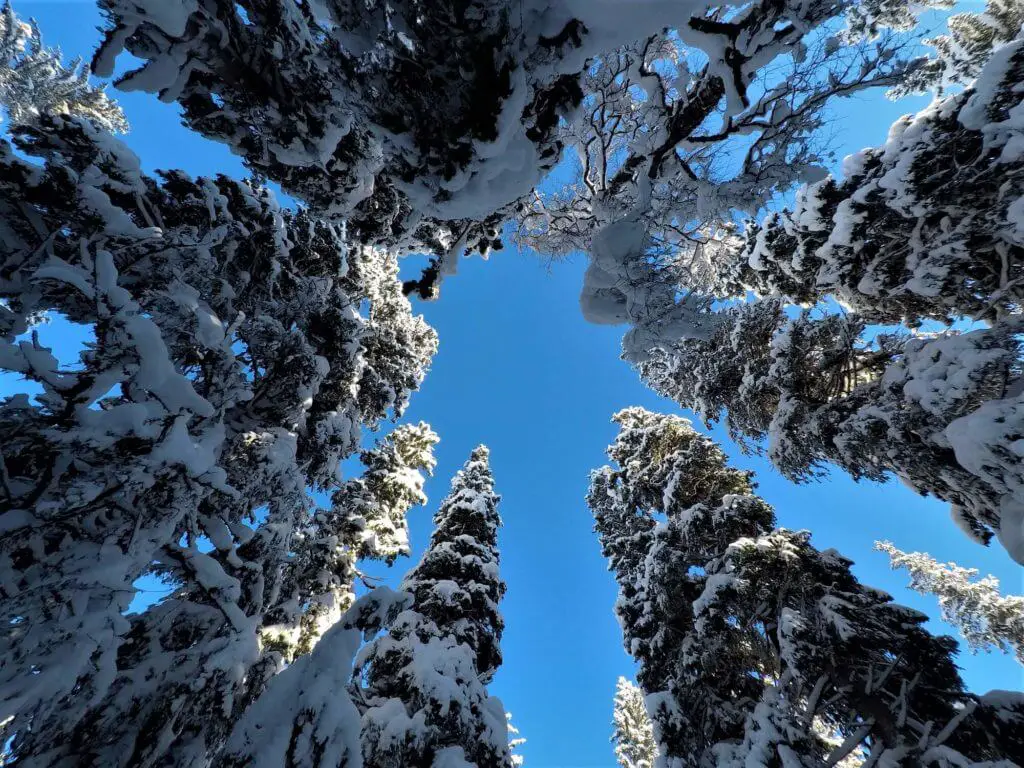
As the snow was so deep we were walking 1-2 metres above the gravel path enjoyed by those undertaking this walk in the summer months. As such, we were often having to stoop to avoid overhanging branches.
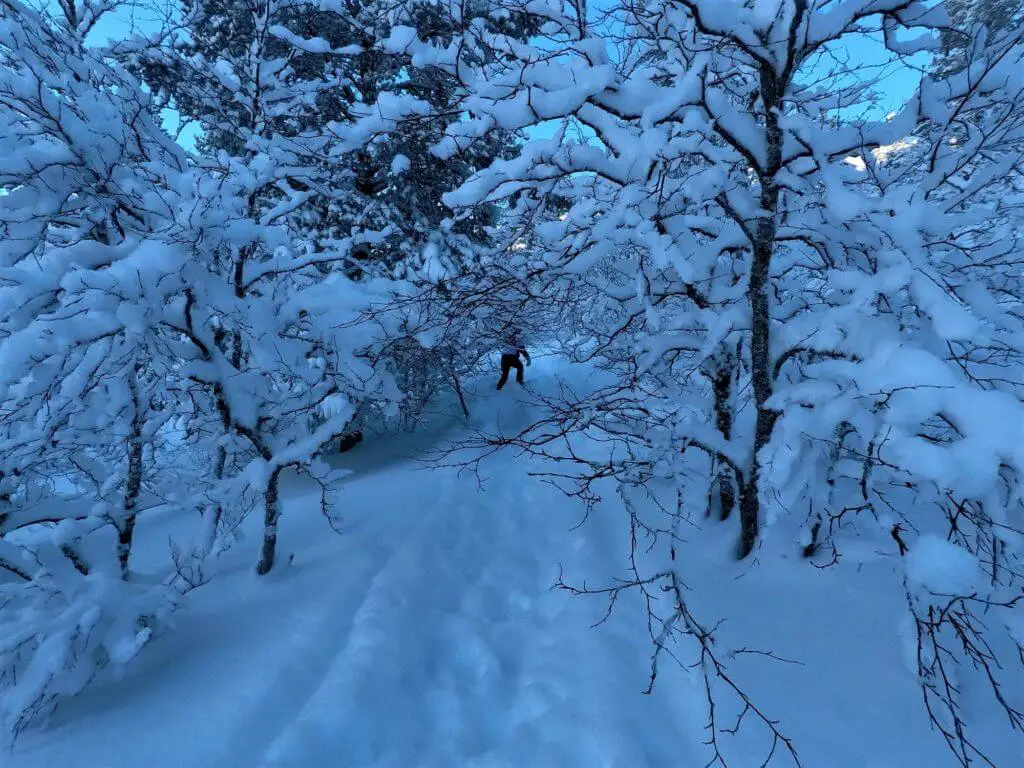
After walking for what felt like an eternity (it was actually only 50 minutes), the trees parted and we were rewarded with our first glimpse of Njupeskär waterfall.
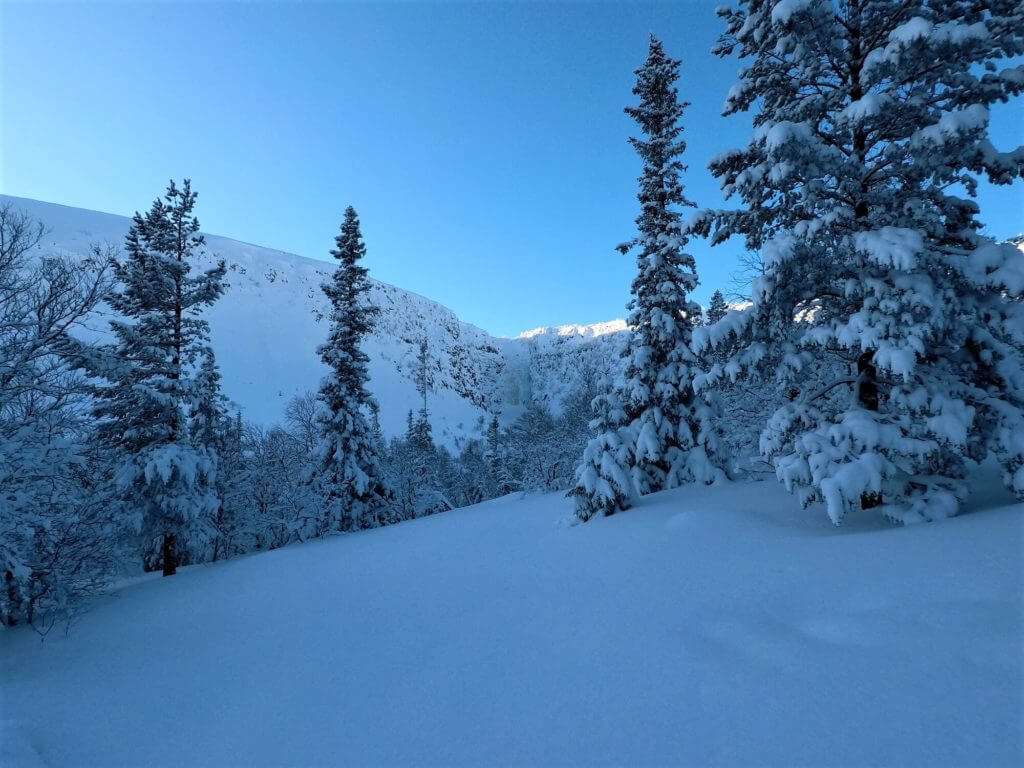
Adjacent to the path there was a small wooden rest cabin. Inside there was a table, ample seating, a couple of reindeer skins and a wood burner. What a great place for hikers to come, rest and thaw out their cold, tired, weary bodies!
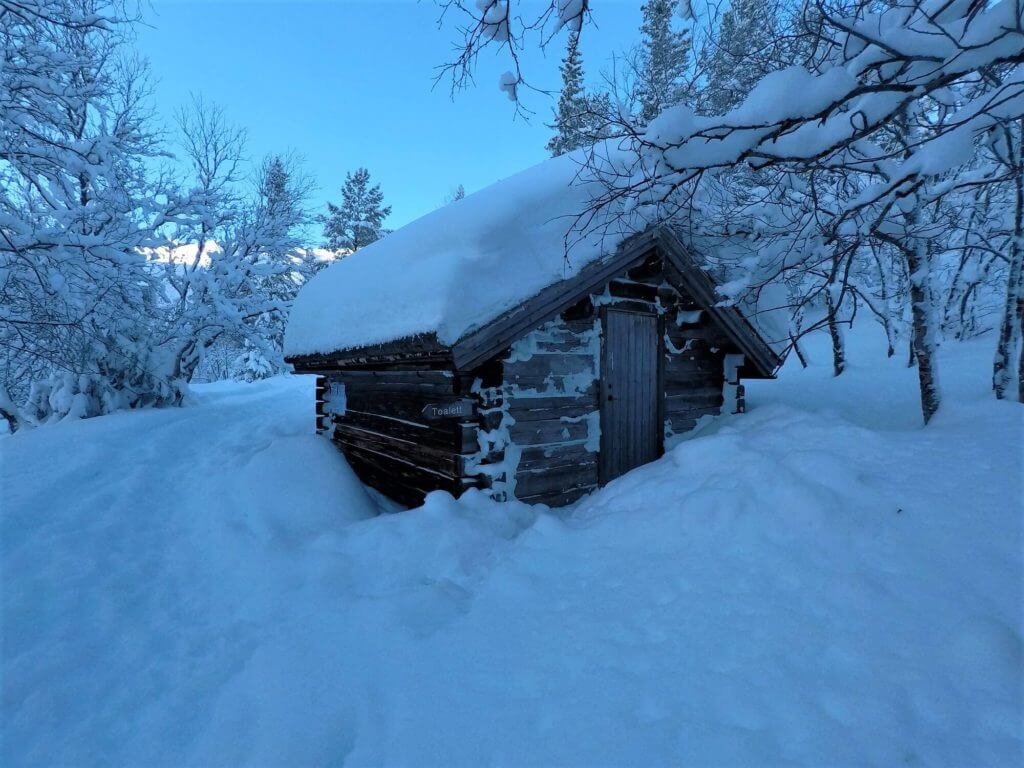
A few minutes on we reached a set of wooden steps leading down to the Njupån river. The steps were completely buried in snow which made the decent just a little precarious!
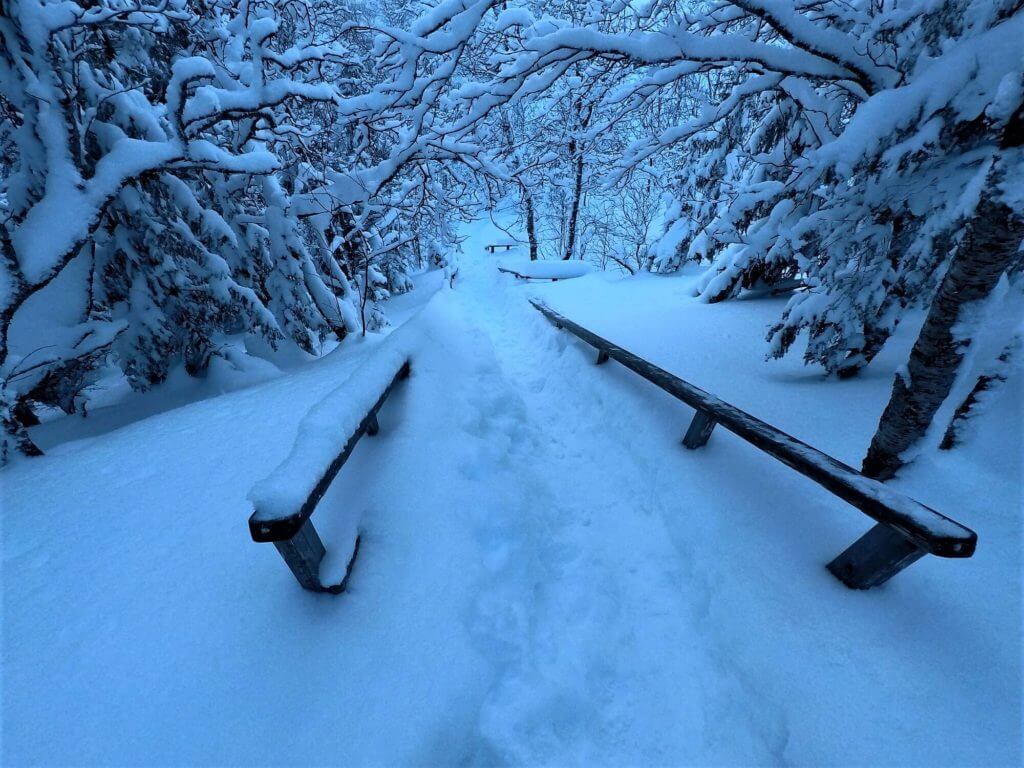
As we crossed the footbridge over the Njupån river, there was the frozen majesty of the Njupeskär waterfall to greet us. The cascading torrent of water that would typically be present in spring, summer and autumn, was now just a thick wall of greenish ice. This was emphasised by the thick, white snowpack that adorned the steep valley either side of the falls.
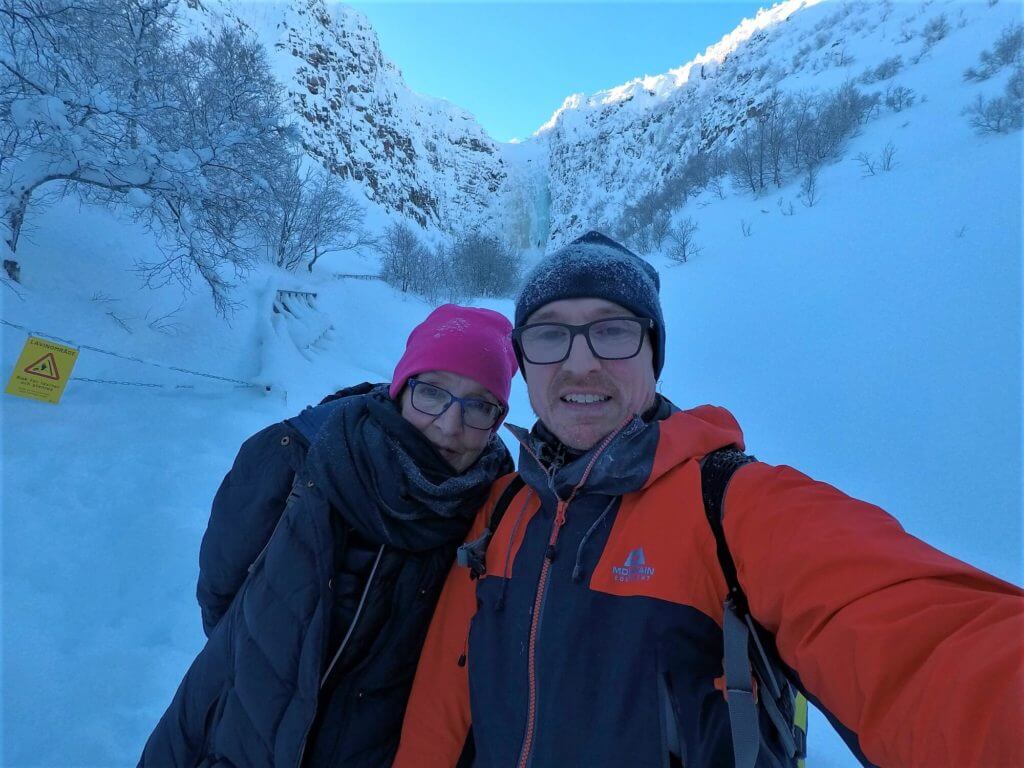
I had wanted to get as close as possible to the falls during our Njupeskär Waterfall Walk. Unfortunately, this was not to be as we soon came across a chain blocking our path, with an avalanche warning sign attached to it.
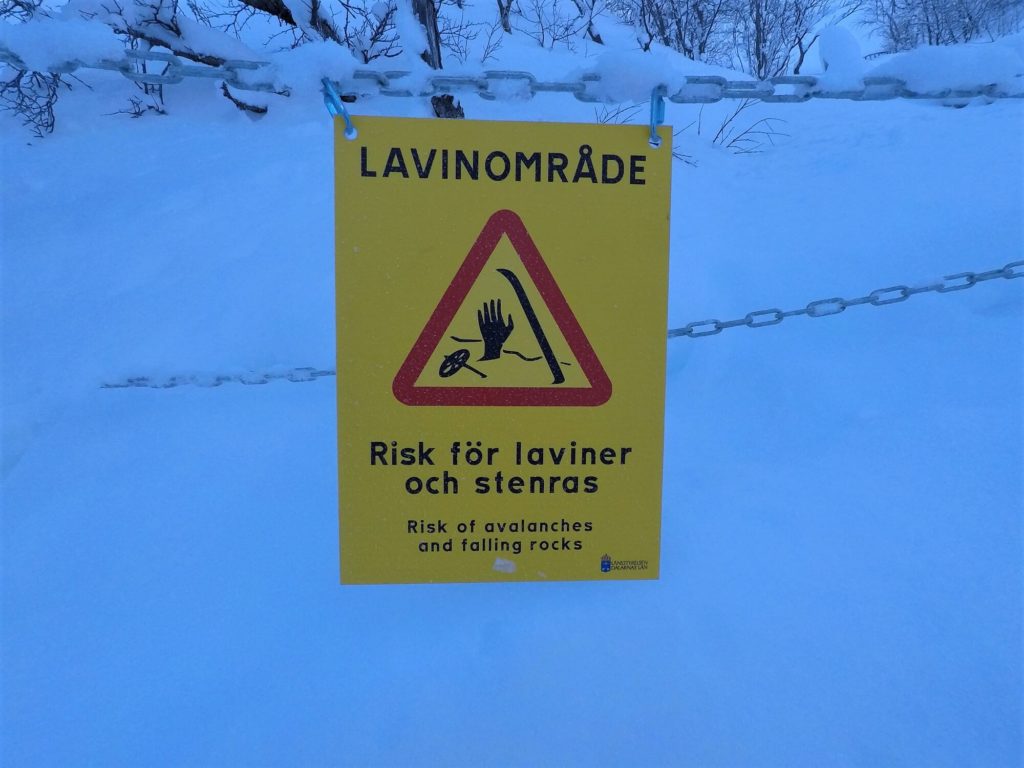
Just one glance up at the extremely steep valley sides and the deep snowpack made us realise that the avalanche warning was totally justified and one that we had no intention of ignoring. We had come within 200-300 metres of the falls, so we were not too disappointed.
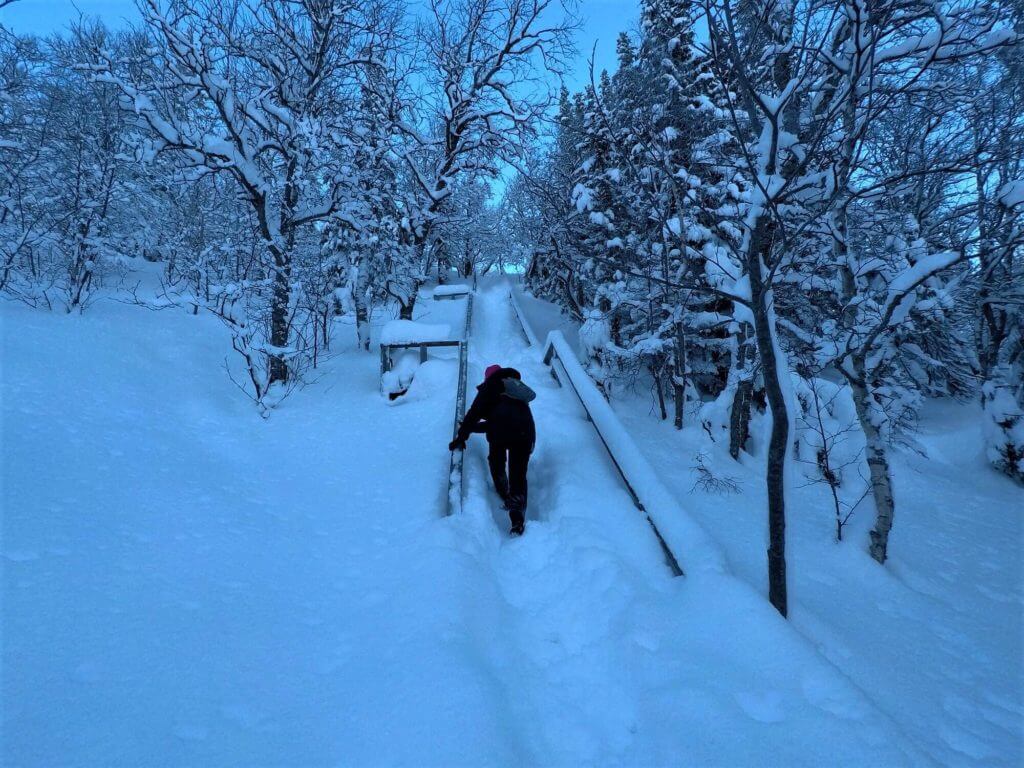
On the walk back, 10 minutes from the carpark, we came across a very unfamiliar sight – PEOPLE – THREE OF THEM. They were three young German tourists heading to the waterfall also. We had a brief chat, shared our Njupeskär waterfall walk experience with them and continued on our way.

As we approached our car, another vehicle entered the car park. It was nice to see that there were others looking to enjoy Fulufjället national park and Njupeskär waterfall in all its winter glory!
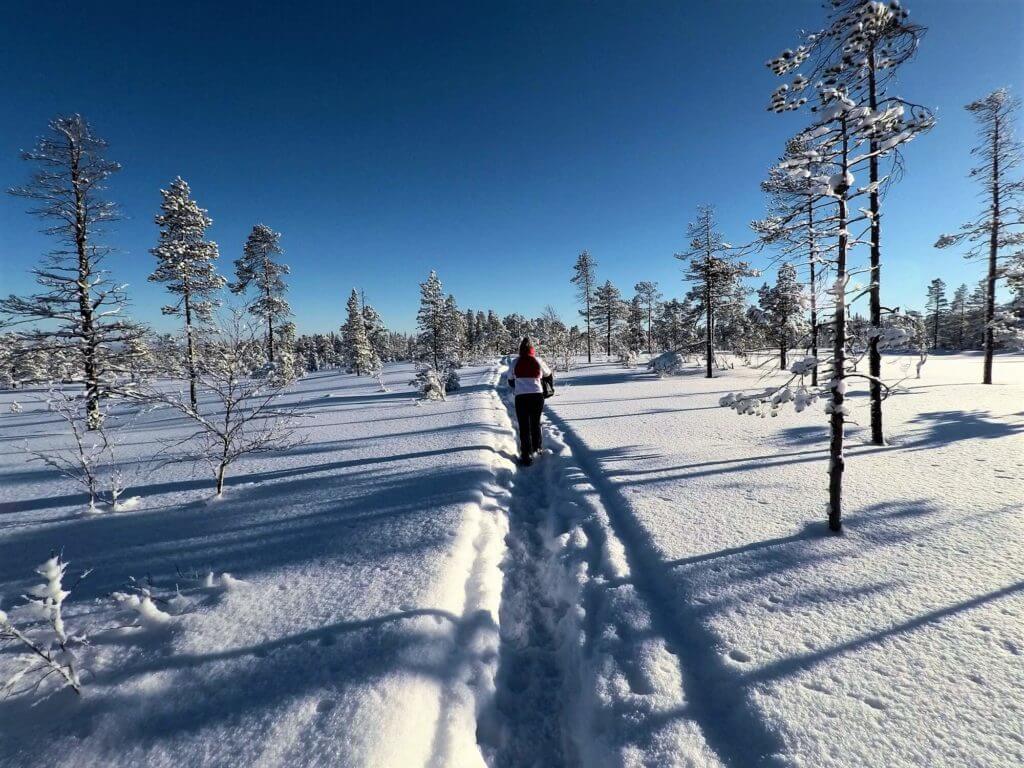
The Njupeskär waterfall walk was complete but its memory would certainly last a very long time!
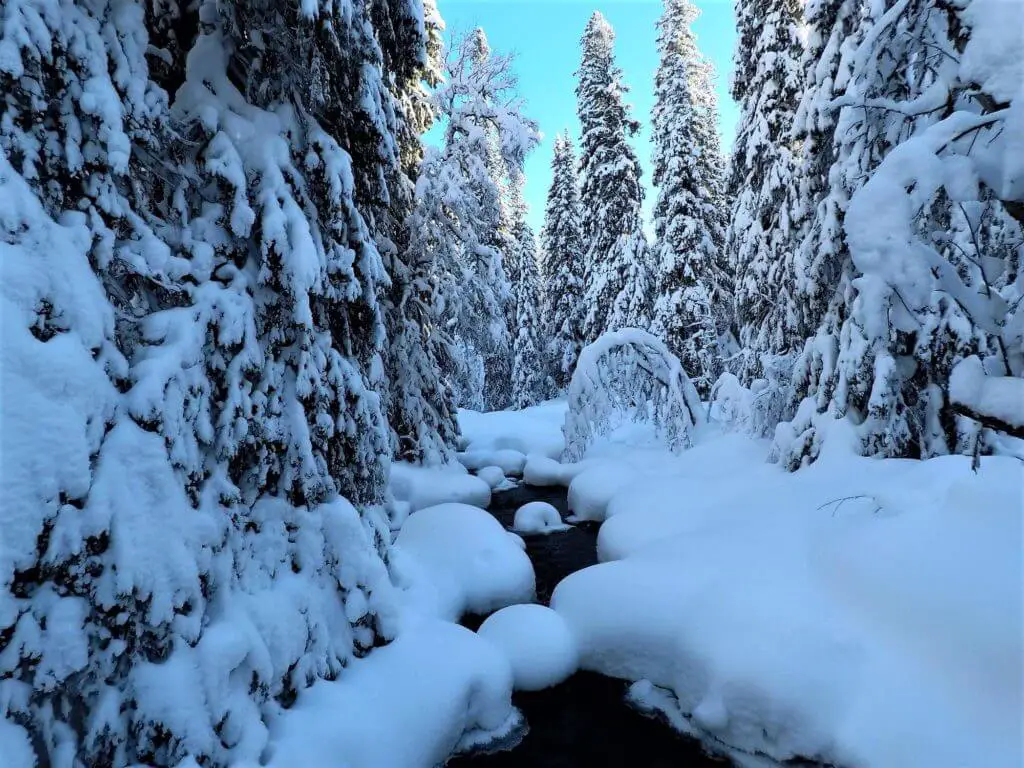
Information About the Njupeskär waterfall walk
How far is the walk?
The walk that we completed is known as the Njupeskärsslingan and is a total of 4km (2km in each direction).
How long does the walk take?
This depends entirely on what time of year you attempt it and the speed at which you walk. It took us a total of 2 hours 10 minutes walking on deep snow.
How difficult is the walk?
Again, this completely depends on when you choose to do it. Even in the depth of winter, it was only moderately challenging.
Fulufjället National Park – Facts, Tips and Activities
General Facts
- Fulufjället National Park is one of Sweden’s newest national parks having been given its status as recently as 2002.
- The park’s total area is 385 km2 (149 sq mi), located entirely within Älvdalen Municipality in the province of Dalarna, Sweden.
- Attracts over 50,000 visitors annually, the majority of which come to visit Njupeskär waterfall.
- Njupeskär waterfall is Sweden’s highest official waterfall. It is 93 metres high with a free fall of 70 metres.
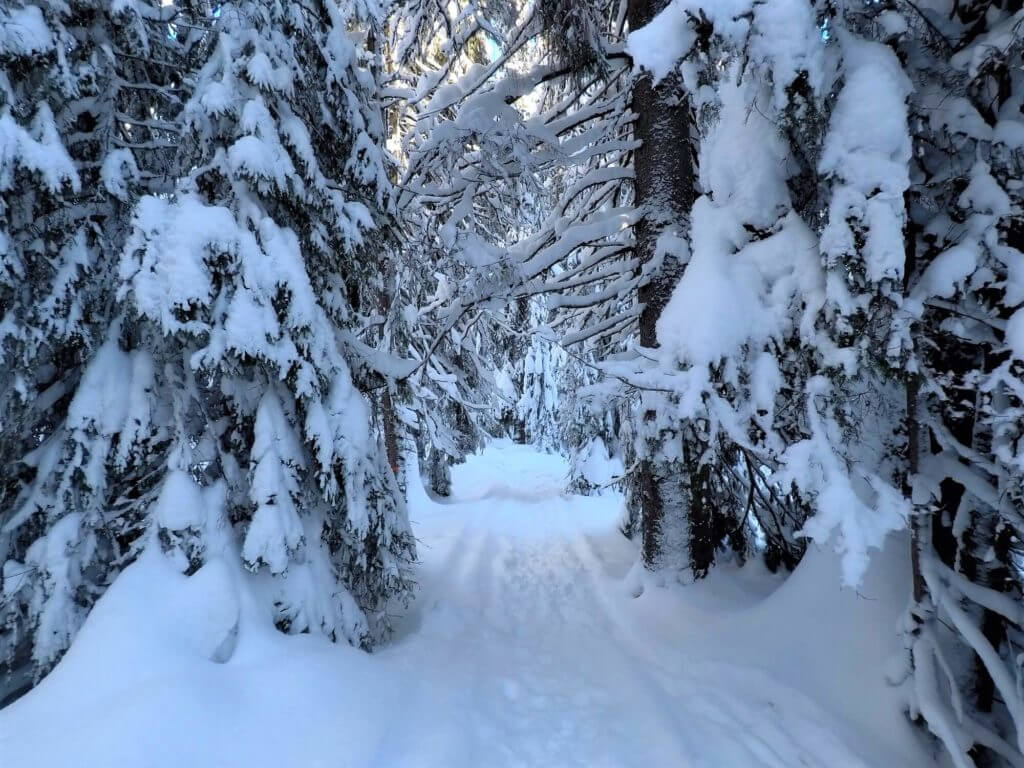
Hiking
Apart from the Njupeskärsslingan that we completed, there is a well-established hiking trail system in the national park, totalling 140km of marked trails. There are also 15 cabins available for resting or overnight stays. Here is a full list of the trails available:
Fulufjället National Park Hiking Trails
Part of the 350km Southern Kungsleden runs through Fulufjället National Park. This trail starts in Sälen (Dalarna) and finishes in Storlien (Jämtland).
Ice Climbing
For all you adrenaline junkies out there who have a passion for ice climbing, you are going to love Njupeskär. From December 1st to March 31st, you are permitted to ice climb on the frozen falls, although the best times are during the months of January and February.
Birdwatching
Fulufjället has an abundance of bird life and many species can be seen year-round in the national park. Gyrfalcon, the world’s largest falcon, is known to sometimes nest at Njupeskär. So, be on the lookout for this rare breed of falcon! The Siberian Jay, symbol of the national park, is a popular breed of bird that can often be seen outside the naturum.
Points of Interest
One of the world’s oldest trees – Old Tjikko
On top of the Fulufjället plateau, one of the world’s oldest trees can be seen. Old Tjikko is a 9559-year-old Norway Spruce. Guided tours to the tree can be organised via the naturum Fulufjället visitor centre in the summer only.
Safety
- If like us you are planning on visiting Fulufjället national park in winter, you had better go prepared. This is especially the case if you are planning a winter hike!
- Wear multiple layers of clothing and a very warm jacket.
- Wear a quality pair of hiking/snow boots, hat and gloves. It can get extremely cold (-18°C during our visit!).
- Make sure that you carry some food and drink with you. Hiking, especially in cold weather, can be calorie sapping so protein snacks are a must.
- Check the Fulufjället weather before arriving. Do not put yourself at risk!
- Make sure that you tell someone where you are going and what time you plan to be back.
- Take a fully charged mobile phone with you.
Check out our comprehensive hiking tips page for further useful advice.
Naturum Fulufjället Visitor Centre
The visitor centre is the place to go if you are looking for:
- Park hiking tips
- Exhibits about Fulufjället
- Guided tours
- And a whole lot more….
However, the centre is not open all year round so please check the opening dates & times before setting out. If you have any questions, contact the visitor centre directly:
Telephone: +46 (0)10-225 03 49
Email: naturum.fulufjallet@lansstyrelsen.se
Our Thoughts
The Njupeskär waterfall walk was everything we had hoped for and is definitely worth adding to your list of places to visit in Sweden during winter (or any other time of year). I am certain that there are many other fantastic waterfalls in Sweden well worth visiting but Njupeskär was a real treat.
If you have any questions about our day in Fulufjället National Park, please drop them into the comment box below and we will get back to you just as quick as we can.
If you have already visited Njupeskär, we would love to hear about your experience also.
Happy hiking!
Like Our Article? Please Pin it!
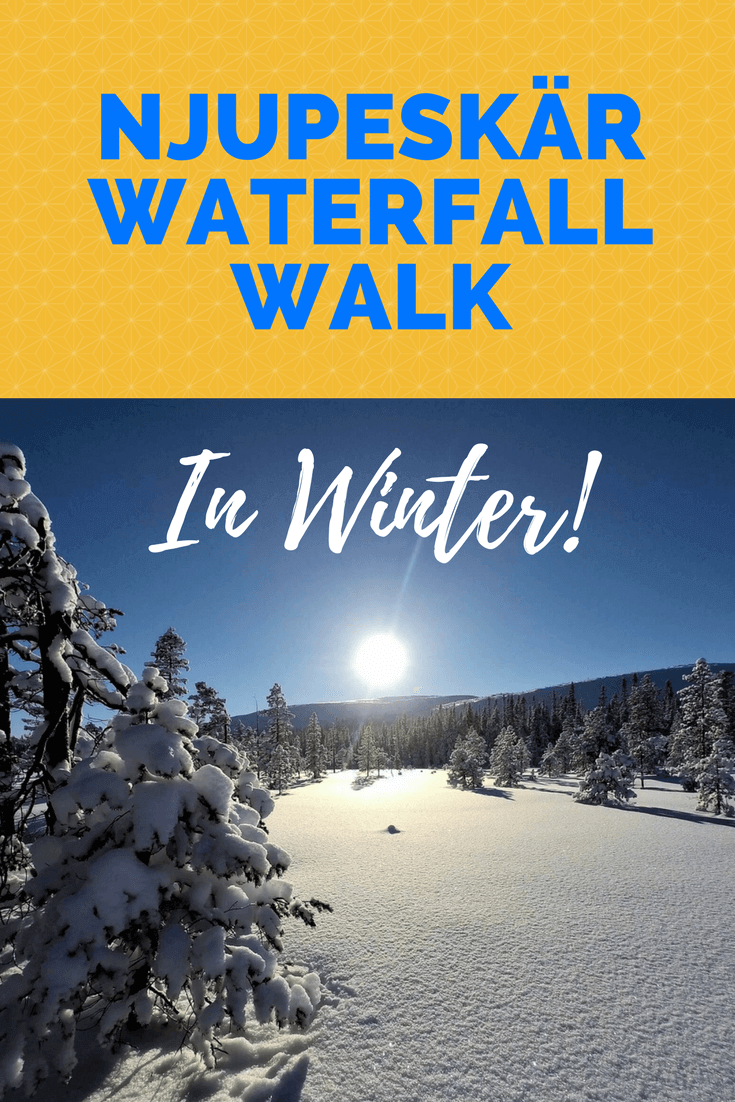

Leave a Reply